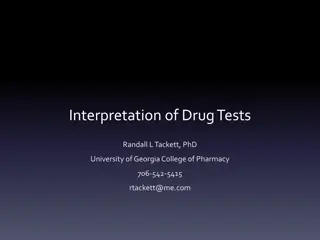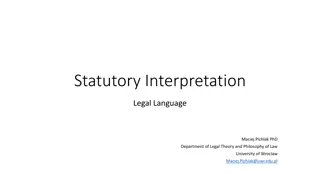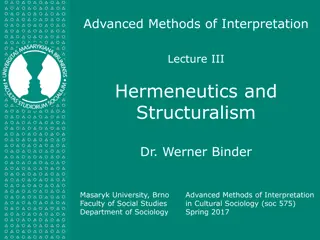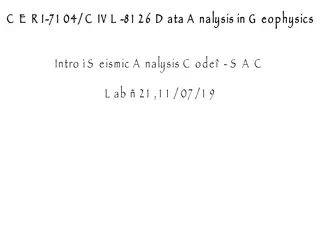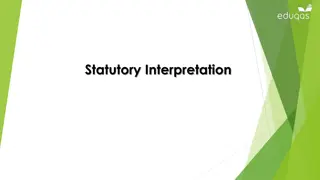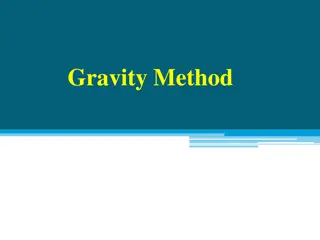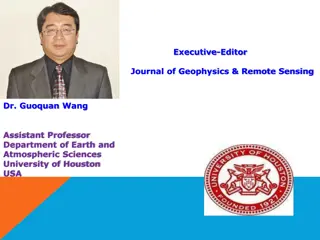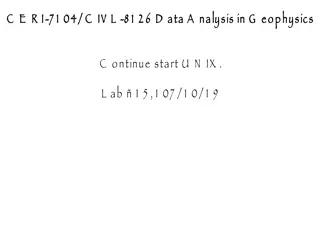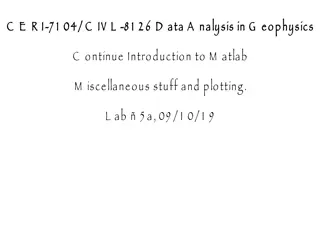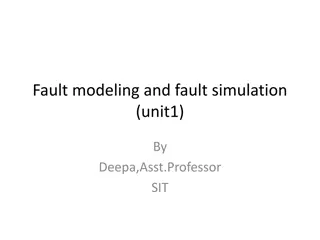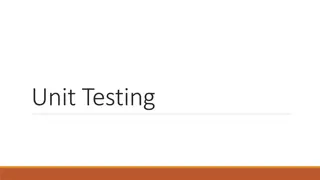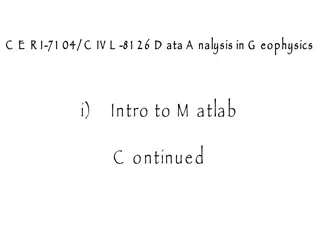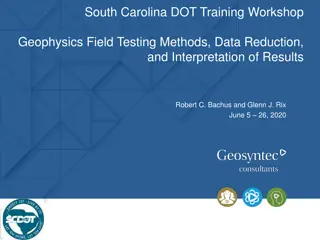Geophysics Field Testing Workshop: Methods and Interpretation
This workshop on geophysics field testing covers a range of methods such as downhole and surface testing, spectral analysis, seismic refraction, and more. Geophysical investigations help assess subsurface properties efficiently and non-invasively, offering valuable insights for site exploration and optimization of drilling locations. While geophysical methods have strengths in coverage and portability, they also come with limitations related to subsurface properties and interpretational challenges.
Download Presentation

Please find below an Image/Link to download the presentation.
The content on the website is provided AS IS for your information and personal use only. It may not be sold, licensed, or shared on other websites without obtaining consent from the author. Download presentation by click this link. If you encounter any issues during the download, it is possible that the publisher has removed the file from their server.
E N D
Presentation Transcript
South Carolina DOT Training Workshop Geophysics Field Testing Methods, Data Reduction, and Interpretation of Results Robert C. Bachus and Glenn J. Rix June 5 26, 2020
Workshop Topics Overview of Geophysical Methods General Background and Wave Mechanics Downhole Testing Methods Crosshole Testing Methods Suspension Logging Methods Surface Wave Methods Spectral Analysis of Surface Waves (SASW) Multi-channel Analysis of Surface Waves (MASW) Microtremor Analysis Method (MAM) Seismic Refraction Seismic Reflection
Workshop Schedule June 5: 9:00 11:30 am June 12: 8:00 am 12:00 pm June 16: 8:00 am 12:00 pm June 22: 8:00 am 12:00 pm June 26: 8:00 am 12:00 pm
Basic Principles Geophysical investigations are used to estimate the physical properties of the subsurface by measuring, analyzing, and interpreting seismic, electrical, electromagnetic, gravitational, and magnetic fields measured at the ground surface or within boreholes.
Strengths Because surface geophysical methods are noninvasive, they provide the ability to cover a large area in a time- and cost-effective manner to gain an understanding of the overall subsurface conditions. This characteristic enables optimizing the locations of borings and soundings during subsequent phases of a subsurface exploration program or interpolating between existing borings and soundings. Geophysical methods are robust in the sense that they are based on fundamental physical principles with relatively little reliance on empiricism. In many cases, the methods used for geotechnical applications leverage the extensive experience gained with similar methods developed for resource (e.g., oil, gas) exploration. Surface geophysical methods are also useful for sites where borings and soundings are difficult or impractical, such as gravel deposits or contaminated soils. The equipment used for many geophysical tests is highly portable, which may allow testing at sites that are not easily accessible (e.g., a heavily wooded area) using conventional drilling equipment.
Limitations Geophysical methods are more likely to yield good results when (i) there is a large contrast in seismic, electrical, electromagnetic, gravitational, or magnetic properties between lithologic units or between an anomaly and the surrounding soils and rocks, and (ii) the subsurface features of interest are of sufficient size relative to their depth that they are within the limits of detection for a particular geophysical method. The interpreted subsurface conditions may not be unique for many geophysical methods; there may be multiple, physically plausible interpretations for the stratigraphy or location and size of anomalies that all yield the same measured geophysical response. For example, a structural low in bedrock topography; a small, air-filled void in the bedrock; or a larger, water-filled void in the bedrock may all produce the same magnitude of gravity anomaly. Sites that have a stiff, surficial layer overlying a weaker layer or an electrically resistive layer over a conductive layer pose a challenge for many surface geophysical tests. For example, many seismic methods do not work well on concrete pavements because of the large stiffness of the pavement compared to the base and subgrade materials.
Implementation Because geophysical methods are less familiar to many geotechnical engineers than conventional site investigation methods (e.g., SPT, CPT), it is essential that geophysical investigations be conducted by personnel who are trained and experienced in near- surface geophysics. The results of geophysical investigations should always be complemented by direct observation of subsurface conditions by means of borings, soundings, test pits, trenches, outcrops, and other geological information. This ground truth information will help ensure that interpreted subsurface conditions derived from geophysical methods are as accurate as possible. The combined use of a geophysical investigation with direct observation is a robust approach to developing an accurate ground model for a project.
Implementation Planning the investigation Executing the investigation Interpreting the results of the investigation Reporting and presenting results of the investigation
Implementation Planning the investigation Developing a geophysical testing plan Selecting the number and locations for in situ tests, drilling, and sampling Determining the minimum depth of investigation at each location Determining the required types of samples and the sampling frequency Developing an in situ and laboratory testing plan Developing a plan for evaluating groundwater conditions Executing the investigation Interpreting the results of the investigation Reporting and presenting results of the investigation
Planning a Geophysical Investigation What are the physical properties of interest? Which methods respond to the physical properties of interest? Which methods can provide the required levels of detection and resolution for the subsurface features of interest? Which methods can perform well given conditions at the project site? Which methods provide complementary information to help improve interpretations based on the observed data? What direct observations (e.g., borings or soundings) should be performed to constrain the interpretation of geophysical data? Which methods are most cost effective, and is the overall geophysical investigation cost effective?
Resolution Resolution: the minimum separation distance required to distinguish adjacent targets for a given geophysical method Depends on contrast Often depends on depth
Surface Geophysical Methods Electrical and Electromagnetic Seismic Potential Field Refraction and Reflection Ground-Penetrating Electromagnetic Magnetometry Surface Wave Self-Potential Microgravity Resistivity Radar Objective Lithology and stratigraphy Bedrock topography Water table Rippability Shear wave velocity profile Fault detection Void and cavity detection Subsurface fluid flow Ferrous anomalies Conductive anomalies Corrosion potential Sources: Fenning and Hasan (1995), USACE (1995), Sirles (2006), FHWA (2006), Anderson et al. (2008)
Borehole Geophysical Methods Gamma-Gamma Density Spontaneous Potential Acoustic Televiewer Seismic Crosshole Seismic Downhole Seismic Logging1 Neutron Porosity Natural Gamma Resistivity Induction Caliper Objectives Lithology Seismic wave velocity profile Fracture location and characteristics Density, porosity, and water content Borehole diameter Source: Paillet and Ellefsen (2005)
ASTM Standards and Guides Geophysical Method ASTM Guide or Standard D6429 D5777 D7128 D6431 G57 D6639 D6820 D6432 D6430 Standard Guide for Selecting Surface Geophysical Methods Seismic Refraction Seismic Reflection Electrical Resistivity Soil Resistivity Frequency-domain electromagnetics Time-domain electromagnetic Ground-penetrating radar Microgravity Source: Sirles (2006) Geophysical Method ASTM Guide Standard Guide for Conducting Borehole Geophysical Logging D5753 Mechanical Caliper D6167 Natural Gamma and Gamma-Gamma Density D6274 Electromagnetic Induction D6726 Neutron D6727 Crosshole Seismic Testing D4428 Downhole Seismic Testing D7400 Source: Sirles (2006)


